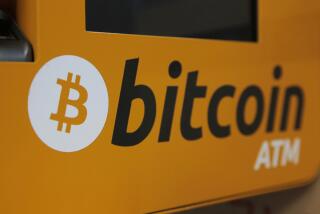There’s an Easy Way to Cash In When You Go : Money: Think you may be stuck for dollars overseas? Don’t fret, automated teller machines keep springing up. And it’s better to use an ATM card than credit.
- Share via
It began as a convenience for bank customers who needed quick cash but didn’t want to stand in long lines. Soon, the automated teller (ATM) became the most popular form of getting cash from your checking account.
Currently, more than 200 million cash and credit cards provided by banks can be used at ATMs. That might work great at your local bank, but what if you need money when you’re traveling?
In the United States, extensive interbank networks such as “Plus” and “Cirrus” allow thousands of ATM cardholders to get cash at virtually thousands of bank branches across the country.
But what about when you’re overseas? Will your little plastic card work? And what about your credit cards and cash advances against your credit limit? If you happen to be traveling in Canada or Western Europe, you could be in luck.
In December, 1988, the Plus system started in a number of banks in England, Scotland and Wales. The system accepts Plus ATM cards and converts dollars to pounds at the current exchange rate and debits your checking or savings account.
Since then, Plus has installed more than 34,600 automated teller machines (nearly 6,000 of them are overseas). You can find them throughout the United Kingdom, in Japan, Australia, Hong Kong, Singapore and Mexico. (Plus, which is linked to Visa International, publishes a complete ATM directory that lists cities, countries, locations. For a copy, call 800-843-7587).
Chicago-based Cirrus offers a similar network of worldwide banks that accept your ATM card. Cirrus claims that it has ATMs in Spain, Canada, China and Japan. Also on-line are Italy, Portugal, Germany and parts of South America.
The Plus machines differ from other cash machines offered by American Express and Diners Club. And rates and charges can differ greatly by card--and sometimes by country.
If you have an American Express green or gold card, you can go into any American Express office worldwide, write a personal check and receive cash or traveler’s checks. If you have an American Express green card, you can write a check for up to $1,000 in any seven-day period. Gold cardholders can write checks within the same period for $5,000.
Platinum cardholder limits jump to $10,000. American Express does not charge a fee for this service. (For check cashing overseas, the same money limits apply, but you can only write a check once every 21 days.)
Both American Express and Diners Club also offer a separate cash-advance plan, where funds are distributed against a prearranged line of bank credit and interest is charged. American Express charges 2% of the withdrawal amount. Diners Club charges 4% of the withdrawal amount.
Officially, the ATM systems overseas are supposed to work. If you believe the advertisements, you can take your ATM card--or your Visa card, MasterCard, Diners Club card or American Express card--virtually anywhere in the world and get a cash withdrawal, or a cash advance.
As an experiment, I’ve tried the ATM routine in Hong Kong, Japan, Bangkok, Nice, Paris and London. I inserted the card into the machine, then punched in my personal identification number and requested $100.
None of the machines worked, and my card was quickly regurgitated from the slot. In almost every case, had I needed the money, I would have had to go into a “participating” bank and get a more costly (and less time-efficient) cash advance.
For the time being, it’s still a good idea to bring your ATM card on your trip, but don’t always count on it to work. Most international banking officials predict that we are just a few years away from a working, fast and efficient global ATM card.
Until then, if you put your ATM card in a machine in London and the system does work, you also need to know that since every financial institution sets its own fees for ATM withdrawals, prices can vary significantly.
Quite simply, there’s a right--and a wrong--credit card or ATM card for the road. Some examples: The average transaction fee for Cirrus banks is 75 cents. Your local bank can then charge you as much as $3 for the transaction.
However, if you use a credit card--not an ATM card--to get cash, be prepared to get hit with a very high price for your money. You will usually be charged a transaction fee, a percentage of the withdrawal amount plus interest as high as 21%. And you stand a strong chance of coming up on the short end in terms of the foreign exchange rate for U.S. dollars.
Recently, a friend used his MasterCard to get 200 from an ATM in London. The official exchange rate that day designated 1 to be worth $1.67. But when my friend got his credit card bill, the exchange rate used had been adjusted to reflect the cost of British currency in the United States and had jumped to $1.81.
Counting the transaction fee of $1.75, and an interest rate on the money of 19.8%, he was charged $362 for his 200, instead of the $334 he anticipated. And remember, when you get your bill, if you don’t pay for the money advanced in total, interest continues to accrue.
Had he used an ATM card linked with the Plus system, the charge would have been a straight $334, with a maximum transaction fee of $2.50, and no interest.
The best advice: If at all possible, never use your credit card to get a cash advance.
Get an ATM from your bank, an updated directory and whatever you do, don’t forget your PIN (personal identification number). Without it--whether in the United States or abroad--you’re out of luck.


